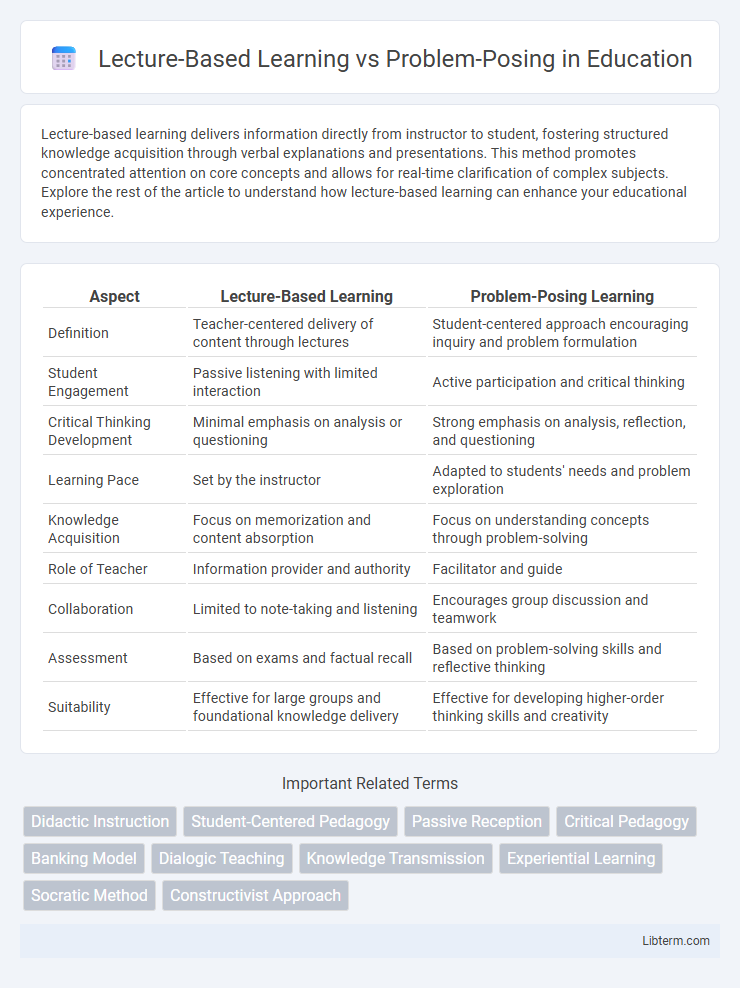Lecture-based learning delivers information directly from instructor to student, fostering structured knowledge acquisition through verbal explanations and presentations. This method promotes concentrated attention on core concepts and allows for real-time clarification of complex subjects. Explore the rest of the article to understand how lecture-based learning can enhance your educational experience.
Table of Comparison
| Aspect | Lecture-Based Learning | Problem-Posing Learning |
|---|---|---|
| Definition | Teacher-centered delivery of content through lectures | Student-centered approach encouraging inquiry and problem formulation |
| Student Engagement | Passive listening with limited interaction | Active participation and critical thinking |
| Critical Thinking Development | Minimal emphasis on analysis or questioning | Strong emphasis on analysis, reflection, and questioning |
| Learning Pace | Set by the instructor | Adapted to students' needs and problem exploration |
| Knowledge Acquisition | Focus on memorization and content absorption | Focus on understanding concepts through problem-solving |
| Role of Teacher | Information provider and authority | Facilitator and guide |
| Collaboration | Limited to note-taking and listening | Encourages group discussion and teamwork |
| Assessment | Based on exams and factual recall | Based on problem-solving skills and reflective thinking |
| Suitability | Effective for large groups and foundational knowledge delivery | Effective for developing higher-order thinking skills and creativity |
Understanding Lecture-Based Learning
Lecture-based learning emphasizes the direct transmission of knowledge from instructor to student, prioritizing clear explanations and structured content delivery. This method is effective for covering extensive material efficiently, promoting retention through repetition and note-taking. However, it may limit critical thinking and active engagement compared to interactive approaches like problem-posing learning.
Defining Problem-Posing Education
Problem-Posing Education is a learner-centered teaching approach that encourages active participation by presenting problems rooted in real-life contexts, fostering critical thinking and dialogue. Unlike traditional Lecture-Based Learning, which emphasizes passive knowledge transfer from instructor to student, Problem-Posing engages learners in questioning, analyzing, and co-constructing knowledge collaboratively. This method promotes deeper understanding by connecting theoretical concepts with practical challenges, enhancing problem-solving skills and cognitive development.
Historical Background of Both Approaches
Lecture-based learning traces its origins to the medieval university model where knowledge was disseminated primarily through oral recitation by a learned authority, emphasizing passive reception of information. Problem-posing education, pioneered by Paulo Freire in the 1970s, emerged as a critical response to traditional pedagogy, advocating for active dialogue and learner engagement to cultivate critical consciousness. These contrasting historical trajectories highlight lecture-based learning's foundation in hierarchical knowledge transmission versus problem-posing's roots in collaborative, experiential learning methodologies.
Key Principles of Lecture-Based Learning
Lecture-based learning centers on the systematic delivery of information from instructor to students, emphasizing structured content organization and clear communication of core concepts. It prioritizes the instructor's role as the knowledge authority, facilitating efficient content transmission and ensuring coverage of essential curriculum topics. This method supports consistent assessment standards and aids learners in building foundational understanding through guided lectures and note-taking.
Core Elements of Problem-Posing Method
Problem-Posing Learning emphasizes active student engagement through questioning, critical thinking, and collaborative problem identification, contrasting with the passive reception in Lecture-Based Learning. Core elements include the generation of meaningful questions, fostering dialogue among learners, and encouraging exploration of multiple perspectives to construct knowledge. This method cultivates deeper understanding and practical application by transforming students into co-creators of knowledge rather than mere receivers.
Benefits of Lecture-Based Instruction
Lecture-based instruction delivers structured content efficiently, facilitating the systematic coverage of complex subjects and ensuring foundational knowledge is consistently conveyed. It supports large group instruction, making it scalable for diverse educational settings and enabling educators to manage time effectively. This method also provides students with clear, expert-driven explanations, which can enhance understanding and retention of key concepts.
Advantages of Problem-Posing Learning
Problem-Posing Learning enhances critical thinking by encouraging students to identify, formulate, and analyze real-world problems actively. This approach fosters deeper engagement and retention, as learners participate in collaborative dialogue and develop problem-solving skills essential for creativity and innovation. Research shows students in problem-posing environments demonstrate improved cognitive flexibility and intrinsic motivation compared to those in traditional lecture-based settings.
Challenges and Limitations of Each Approach
Lecture-based learning often faces challenges such as passive student engagement, limited critical thinking opportunities, and difficulties in addressing diverse learning paces. Problem-posing methods may encounter limitations including increased time demands, the need for trained facilitators, and potential student frustration with open-ended questions. Both approaches require careful implementation to balance structure and interaction for effective learning outcomes.
Impact on Student Engagement and Outcomes
Lecture-based learning often results in passive student engagement, limiting critical thinking and reducing long-term knowledge retention, as students primarily absorb information without active participation. In contrast, problem-posing methodologies stimulate deeper cognitive involvement by encouraging students to identify and analyze problems, which enhances motivation, critical reasoning skills, and academic outcomes. Studies show that learners exposed to problem-posing techniques demonstrate higher engagement levels and improved problem-solving abilities compared to traditional lecture-based settings.
Choosing the Right Method for Different Contexts
Lecture-Based Learning efficiently delivers structured content to large audiences, making it ideal for foundational knowledge acquisition in disciplines like history or biology. Problem-Posing engages learners in critical thinking and real-world application, enhancing skills in fields such as engineering or social sciences that require analytical problem-solving. Selecting the appropriate method depends on learning objectives, content complexity, and student engagement levels to maximize educational outcomes.
Lecture-Based Learning Infographic

 libterm.com
libterm.com